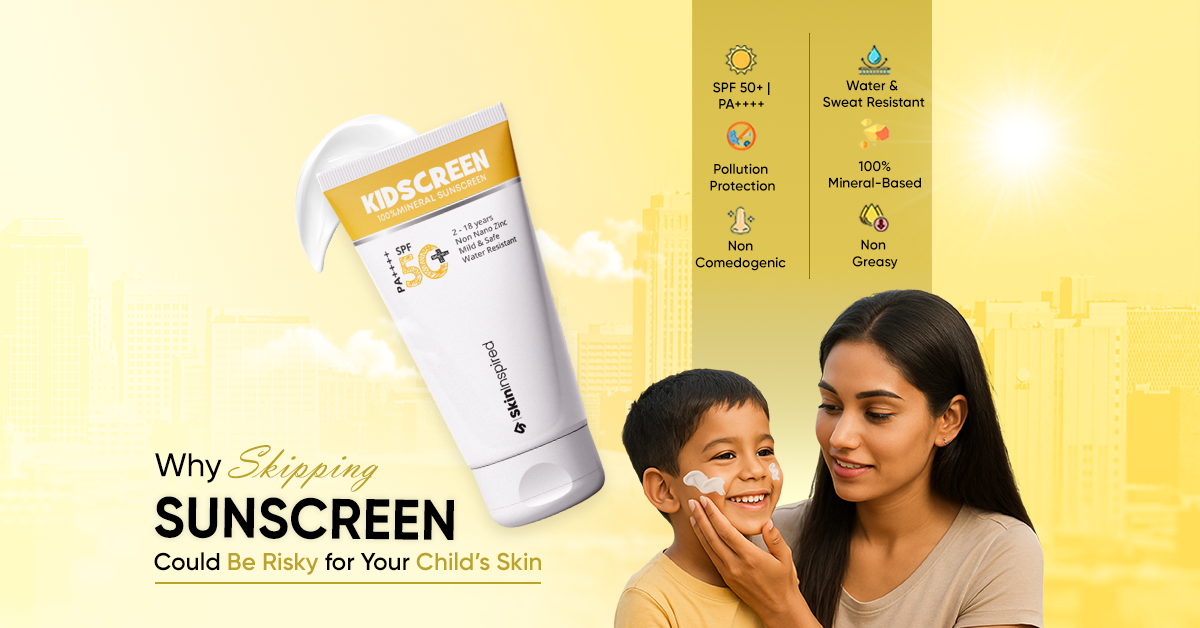At SkinInspired, we believe skincare is a lifelong journey that starts earlier than most people realize. While many parents pay close attention to their child’s nutrition, screen time, and hygiene, sun protection often doesn’t get the attention it deserves.
The question we want every parent to ask is this: “Does my child really need sunscreen every day?”
The answer is yes. Skipping sunscreen in childhood isn’t just a small oversight; it can lead to long-term risks for your child’s skin.
Children’s Skin Needs Extra Protection
Children have delicate, thinner skin that’s still developing. Unlike adult skin, it contains fewer natural protective barriers, making it more susceptible to sunburn, irritation, and long-term sun damage.
At SkinInspired, we’ve studied how early UV exposure contributes to:
-
Sunburns that damage skin cells deeply
-
Hyperpigmentation and early onset of skin discoloration
-
Premature aging due to collagen breakdown
-
Increased risk of skin cancers later in life
What’s alarming is that 80% of lifetime sun damage occurs before the age of 18. That’s why starting suncare early is so important, and it’s not something to skip.
The Indian Skin and Our Misconceptions
It’s a popular myth that darker Indian skin is naturally protected and doesn’t need sunscreen. While melanin does offer some natural defense against UV rays, it is not enough to prevent long-term damage.
India experiences high UV levels across most regions throughout the year. Whether it’s a cloudy winter morning or a humid monsoon day, UV rays remain present. Even indirect exposure through windows or while playing under the shade can harm the skin. This makes sun protection not a seasonal concern, but a daily necessity.
Consequences of Skipping Sunscreen
Without regular sun protection, children may experience:
-
Sunburns: Painful redness, peeling, or even fever in more severe cases.
-
Hyperpigmentation: Uneven skin tone and dark patches, often caused by hyperpigmentation, can become more noticeable over time.
-
Premature Aging: Repeated exposure to UV radiation can reduce collagen production, leading to early signs of aging.
-
Skin Sensitivity: There is a higher risk of skin reactions and worsening conditions, such as eczema, in individuals with sensitive skin.
-
Higher Risk of Skin Cancer: Long-term DNA damage caused by UV rays significantly raises the risk of skin cancers.
At SkinInspired, our goal is to provide parents with simple, yet effective solutions that protect sensitive skin without irritation.
Introducing KidScreen by SkinInspired
We created KidScreen SPF 50+ PA++++ to offer high-performance sun protection tailored to the needs of children’s skin. Here’s what makes KidScreen stand out:
Key Benefits:
SPF 50+ Protection: By blocking up to 98% of UVB rays, SPF 50+ helps protect your child’s skin from sunburn, tanning, and damage during outdoor play.
High PA Rating: Powered by PA++++, it shields the skin from UVA rays that cause pigmentation, damage, and premature aging.
Mineral-Based Formula: Made with a gentle mineral-based formula, this zinc oxide sunscreen creates a physical barrier that reflects UV rays for even the most sensitive skin types.
Lightweight & Non-Sticky: The lightweight, non-sticky texture blends easily with no white cast and feels comfortable for everyday wear.
Water & Sweat Resistant: With this, Kidscreen stays effective through swimming, running, and outdoor fun all day long.
With KidScreen, you don’t have to choose between safety and comfort. It’s sunscreen your child won’t complain about, and you can feel confident using every single day.
When Should You Apply Sunscreen to Kids?
The key to adequate sun protection is consistency. Applying mineral sunscreen should be a daily habit for kids, just like brushing their teeth.
Here’s a simple routine guide from SkinInspired:
Morning: Apply generously to face, arms, and any exposed area 15–20 minutes before leaving the house.
Every 2–3 hours: Reapply every 2 to 3 hours, especially after playing, sweating, or wiping the face.
Even on Cloudy Days: Use Sunscreen Even on Cloudy Days, as UV Rays Can Pass Through Clouds and Glass.
For School Bags: Keep a sunscreen tube in your child’s school or activity bag for easy touch-ups.
Sunscreen Myths Many Parents Still Believe
Let’s address a few common myths:
Myth 1: My child doesn’t burn or tan, so sunscreen isn’t necessary.
UV rays can still damage the skin beneath the surface, even without visible signs like burns or tanning.
Myth 2: Sunscreen is only needed at the beach or on holidays.
Wrong. Every day exposure, from school runs to playground time, causes more cumulative damage than occasional sunbathing.
Myth 3: Sunscreen is greasy and irritates my child’s skin.
Not when it’s made for kids. That’s why we created KidScreen to eliminate the heavy, sticky feel and offer irritation-free comfort.
Myth 4: Won’t sunscreen block Vitamin D?
Sunscreen only reduces excess UV exposure. Kids still get enough sunlight to produce Vitamin D even with protection.
Tips to Make Sunscreen a Daily Habit
-
Apply it each morning, just like you never skip brushing your teeth.
-
Lead by example, if your child sees you using broad-spectrum sunscreen daily, they’re more likely to follow suit.
-
Keep a tube in the school bag for reapplication during day trips or sports.
-
Praise them for remembering to apply sunscreen themselves!
Final Thoughts: A Simple Step with a Lifelong Impact
As parents, the goal isn’t just short-term safety, but long-term skin health for our children. Sunscreen might seem like a small addition to your child’s day, but the long-term benefits are massive.
From preventing sunburn and pigmentation to reducing cancer risks and maintaining healthy, youthful skin, a good sunscreen like KidScreen can make all the difference. So the next time your child steps out, even if it’s for just 10 minutes, make sure they’re covered in care and protected with sunscreen.


